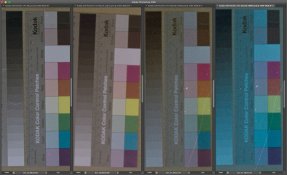Rafael Saffirio
Member
Hi.
I did a test of the "David Lyga Method" of processing C-41 in diluted developer. For this I used fresh Kodak ColorPlus 200 the developer was Arista C-41 Liquid Kit mixed the same day processed in paterson tank at 38-39 C then I scanned everything in Nikon LS-1000 (I know, I know very very ancient scanner) with VueScan saved has DNG raw, converted in PS 6.0 same settings for everything (except one, more on that later) the I measured the color in a 11x11 px average and did some graphs.
Here are the numbers: https://docs.google.com/spreadsheets/d/1io1UzuFPE7GuurgCrqZyvHYpW7JNBEpEP4K96PljhVo/edit?usp=sharing
I did tree test:
From left to right: C41 normal Blix, C41 Bleach Fix, C41 Diluted white balance on mid gray, C41 Diluted, same white balance as C41 normal.
I don't know if I will use the diluted method because I prefer to reuse the developer and increase the time, but is good to know that it works

As you can see there are color shift to the blue in the diluted form, but in PS and scanning is quite easy to correct, and I believe in RA-4 printing also is possible I will test that and post the results.
The Raw scans:
https://drive.google.com/file/d/122Gj6vVT3co-vKoikhnXube8LtEnDBRg/view?usp=sharing
https://drive.google.com/file/d/1H2vNjXy4MaKLrQuKI_gvNhTVRsXgbmx5/view?usp=sharing
https://drive.google.com/file/d/1c8G6Y8caugmeEZbPmK_NlqWFfFAM1Wzn/view?usp=sharing
I did a test of the "David Lyga Method" of processing C-41 in diluted developer. For this I used fresh Kodak ColorPlus 200 the developer was Arista C-41 Liquid Kit mixed the same day processed in paterson tank at 38-39 C then I scanned everything in Nikon LS-1000 (I know, I know very very ancient scanner) with VueScan saved has DNG raw, converted in PS 6.0 same settings for everything (except one, more on that later) the I measured the color in a 11x11 px average and did some graphs.
Here are the numbers: https://docs.google.com/spreadsheets/d/1io1UzuFPE7GuurgCrqZyvHYpW7JNBEpEP4K96PljhVo/edit?usp=sharing
I did tree test:
- Normal process by the Arista Kit instruction
- C-41 Developer Stock with separate bleach and fix
- C-41 Developer diluted 1+9 plus the addition of 1gr of sodium carbonate monohydrate
| Process | Time |
| Developer | 3:30 / 8:00 |
| Stop | 0:30 |
| Clear | 1:00 |
| Wash | 1:00 |
| Bleach | 3:00 |
| Wash | 1:00 |
| Clear | 1:00 |
| Fix | 3:00 |
| Wash | 3:00 |
| Stab | 1:00 |
- Fixer is Ilford Rapid 1+4
- Clearing bath: 500 ml water, Sodium sulfite, anhydrous, 15 g, Sodium metabisulfite, 5 g
- Bleach: 350 ml water, Potassium Ferricyanide 28g, Potassium Bromide 7g
From left to right: C41 normal Blix, C41 Bleach Fix, C41 Diluted white balance on mid gray, C41 Diluted, same white balance as C41 normal.
I don't know if I will use the diluted method because I prefer to reuse the developer and increase the time, but is good to know that it works

As you can see there are color shift to the blue in the diluted form, but in PS and scanning is quite easy to correct, and I believe in RA-4 printing also is possible I will test that and post the results.
The Raw scans:
https://drive.google.com/file/d/122Gj6vVT3co-vKoikhnXube8LtEnDBRg/view?usp=sharing
https://drive.google.com/file/d/1H2vNjXy4MaKLrQuKI_gvNhTVRsXgbmx5/view?usp=sharing
https://drive.google.com/file/d/1c8G6Y8caugmeEZbPmK_NlqWFfFAM1Wzn/view?usp=sharing








 I just see it "more blue"
I just see it "more blue"






